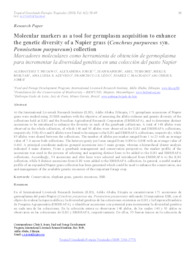Molecular markers as a tool for germplasm acquisition to enhance the genetic diversity of a Napier grass (Cenchrus purpureus syn. Pennisetum purpureum) collection.
Molecular markers as a tool for germplasm acquisition to enhance the genetic diversity of a Napier grass (Cenchrus purpureus syn. Pennisetum purpureum) collection.
Autoria: NEGAWO, A. T.; JORGE, A.; HANSON, J.; TESHOME, A.; MUKTAR, M. S.; AZEVEDO, A. L. S.; LEDO, F. J. da S.; MACHADO, J. C.; JONES, C. S.
Resumo: Abstract At the International Livestock Research Institute (ILRI), Addis Ababa, Ethiopia, 171 germplasm accessions of Napier grass were studied using 20 SSR markers with the objective of assessing the allelic richness and genetic diversity of the collections held at ILRI and the Brazilian Agricultural Research Corporation (EMBRAPA), and to determine distinct accessions to be introduced to enhance the diversity in each of the genebank collections. A total of 148 alleles were observed in the whole collection, of which 140 and 93 alleles were observed in the ILRI and EMBRAPA collections, respectively. Fifty-five and 8 alleles were found to be unique to the ILRI and EMBRAPA collections, respectively, while 85 alleles were shared between the collections. The number of alleles per marker ranged from 1 to 23 with an average value of 7.4 across both collections. The heterozygosity per locus ranged from 0.000 to 0.808 with an average value of 0.463. A principal coordinate analysis grouped accessions into 3 main groups, whereas a hierarchical cluster analysis indicated 4 main clusters. From a genebank management and conservation perspective, the marker profile of the accessions was used in the process of selecting and acquiring distinct lines to be added to the ILRI and EMBRAPA collections. Accordingly, 54 accessions and elite lines were selected and introduced from EMBRAPA to the ILRI collection, while 8 distinct accessions from ILRI were added to the EMBRAPA collection. In general, a useful marker profile of an expanded Napier grass collection has been generated which could be used to enhance the conservation, use and management of the available genetic resources of this important forage crop.
Ano de publicação: 2018
Tipo de publicação: Artigo de periódico
Unidade: Embrapa Gado de Leite
Palavras-chave: Conservation, Elephant grass, Genetic resources, SSR
Observações
1 - Por padrão são exibidas publicações dos últimos 20 anos. Para encontrar publicações mais antigas, configure o filtro ano de publicação, colocando o ano a partir do qual você deseja encontrar publicações. O filtro está na coluna da esquerda na busca acima.
2 - Para ler algumas publicações da Embrapa (apenas as que estão em formato ePub), é necessário ter, no celular ou computador, um desses softwares gratuitos. Sistemas Android: Google Play Livros; IOS: iBooks; Windows e Linux: software Calibre.
Acesse outras publicações
Acesse a Base de Dados da Pesquisa Agropecuária (BDPA) para consultar o acervo completo das bibliotecas da Embrapa.

